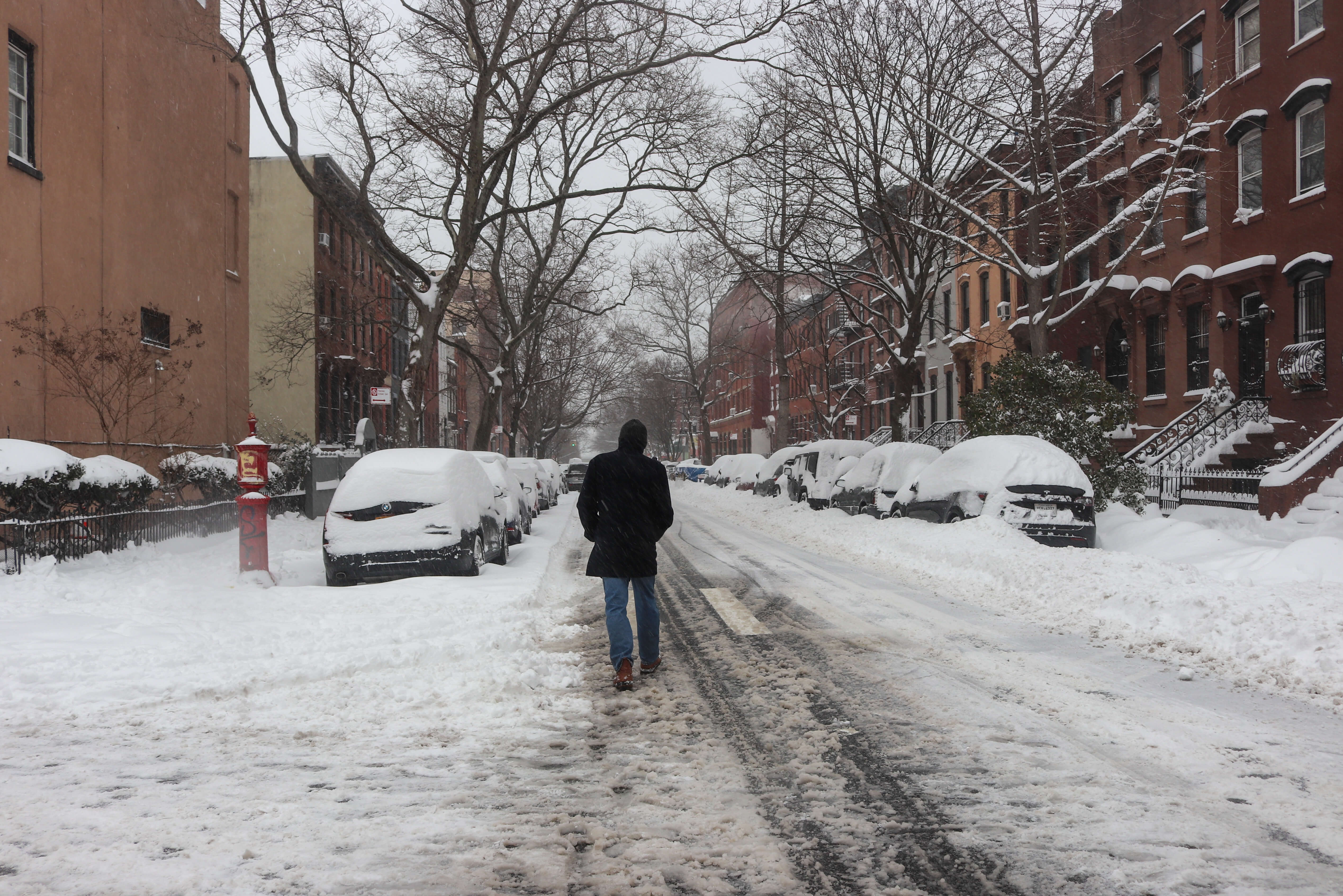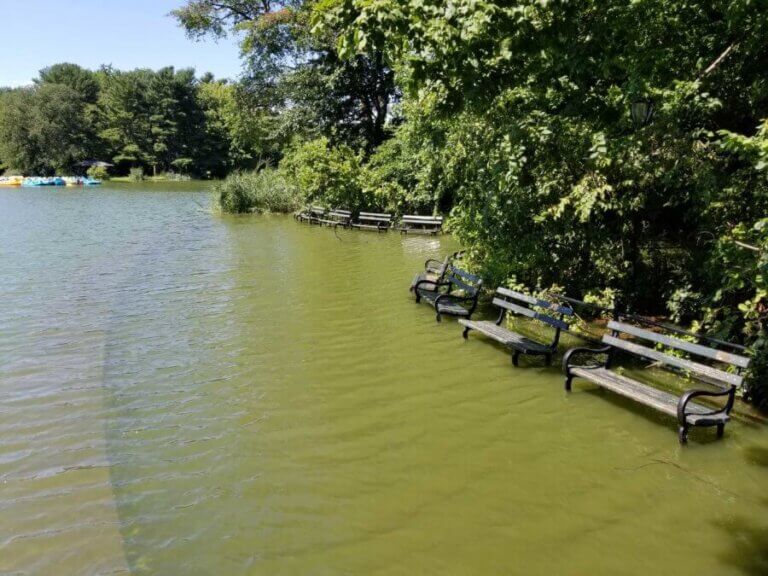Climate Change and Warmer Winters Mean More Rain and Flooding in Brooklyn
As the borough grapples with newly set climate records seemingly each year, residents are struggling to protect themselves and their communities.

‘Pretty surreal’; warmer winters and climate change continue to harm Brooklyn. Photo by Susan De Vries
By Isabel Song Beer
From flooded waterfronts to the hottest summer in documented history, Brooklynites are confronting the unmistakable signs that climate change is no longer a distant threat, but an imminent one. As the borough grapples with newly set climate records seemingly each year, residents are struggling to protect themselves and their communities.
Climate change coupled with naturally occurring weather phenomena like El Niño and La Niña result in more dramatic weather events like the intense rain storms Brooklyn experienced this winter.
Climate change affects typical weather patterns
“Typically, we have these trends in the northern mid-Atlantic where we’ll have a string of snowless winters, quiet winters and then we’ll have strings of winters where we’ll get smacked big time wave after wave of snowfall,” meteorologist and owner of NYNJPA Weather Steven DiMartino told Brooklyn Paper. “Over the past three years we’ve had La Niña, where you typically get what’s called a ridge setting up over the east of the United States. And although we start off cold in November and December, the rest of the winter ends up being pretty mild. Then there’s El Niño — this is where waters in the Pacific ocean are warmer. What you get is that the start of winter is mild, which is typical, and then January and February get very cold and stormy and that usually leads to our very active storm systems and our very active winters.”
This winter, DiMartini said, the five boroughs are experiencing El Niño — a typical and expected weather occurrence for New Yorkers. What is atypical, though, is how much warmer waters in the Pacific ocean are due to climate change.

“When you start to warm the oceans, you start to create an environment where your La Niña can last much longer and they’ll be stronger,” DiMarinto said. “That’s something that’s still being studied, but that is a theory that’s out there and it explains why the past La Niña lasted for three years, which has only happened two other times in recorded history.”
While areas such as Red Hook, Coney Island, and Ditmas Park are contending with more frequent and severe flooding as a result of rising sea levels, extreme weather events and a lack of suitable infrastructure, residents across the borough struggle with the unique side effects of climate change throughout their communities.
“In terms of year-to-year, there’s more rainfall, but also with these warmer winters we’re getting less snow and more rain,” Willis Elkins, executive director of the Newtown Creek Alliance, told Brooklyn Paper on January 10 — the day after a major city rainstorm. “It’s been about 700 or so days since we’ve had an inch of snow in the city, which is pretty surreal to hear.”
Elkins explained that, as a result of the heavy precipitation during the January 9 night storm, the Newtown Creek Wastewater Treatment Plant experienced sewage overflow into the creek.
“This can result in a few things,” Elkins said. “The main thing is combined sewer overflow, [which] has severe impacts on the health of the creek and in all of New York City — all the waterways.”
“It also creates more challenges for the sewer infrastructure,” she added. “We’ve seen this a lot too with the bigger storms we’ve had, where there’s more flooding and the capacity of the sewer systems can’t handle the amount of rain we’re getting.”

But if it were all snow, Elkins said, things would be a bit easier.
“If were all snow it would not have gone through the sewer system,” she said. “A lot of that would be on the street now, some of that might melt off more gradually but it would reduce the impacts.”
Other areas in Brooklyn — particularly southern Brooklyn — are now at a much higher risk of flooding during any significant rainfall, particularly after the infrastructural damage caused by Hurricane Sandy in 2012.
Elected officials like Assembly Member Robert C. Carroll, who represents Brooklyn’s 44th Assembly District, are working to establish more failsafes to protect residents who live in areas at risk of flooding, as well as to mitigate or reverse damage caused by climate change.
“We know that places — whether it be Ditmas Park, Kensington, Borough Park, parts of Windsor Terrace or Park Slope — that there are blocks that, now when we have these rain events, they flood regularly, and how do we mitigate that?” Carroll said. “Some of it is by changing topography and looking at [other] ways, whether it be bioswales or opening up more green spaces or making sure that our sewers are at capacity.”
According to a study by home insurance group Bankrate, one of the biggest concerns for homeowners is the impact of climate change on their properties. The group recently found that 57% of US adults say they’ve had to pay for repairs due to an extreme weather event within the past 10 years — and that they expect climate-related costs will have a negative impact on their finances over the next decade.
Protecting New Yorkers with legislation
In an effort to keep his constituents and residents living in flood zones informed about the risks of damage, Carroll introduced the flood risk Right to Know legislation in 2022. The law, passed last June, requires that homebuyers be informed of flood risks before buying a property, as well as past flood history and information about flood insurance during a property sale.
Additionally, Carroll introduced the Build Public Renewables Act, which passed last May. That legislation requires the New York Power Authority to provide residents with renewable energy and power to customers — one of the most significant climate change-related bills to pass in this country.
“I think that the goal of all of our elected officials and leaders throughout our state is to find ways to implement smart pieces of public policy to blunt the effects of climate change as much as humanly possible and hopefully to reverse some of its worst effects,” Carroll said.
But it’s not all doom and gloom when it comes to climate change and the environment. While it is not possible to completely reverse the effects that humans have had on the planet or the effects of climate change, any and every bit of avoided future temperature increases can result in dramatically less future damage.
“I’m a big believer in the phrase ‘think global, act local’” said Carroll. “I think we can really be an example as a community, as a city to try to show how we can decarbonize our economy in a thoughtful, smart way.”
To start, he told Brooklyn Paper, New Yorkers must do their part.
“I think oftentimes when we look at problems and we say we have to solve every part of it tomorrow, it becomes daunting and nothing happens,” he said, “but we can make real choices in New York to decarbonize our energy grid, to work to make our buildings more efficient, to work to encourage mass transit — all of which will be very helpful to our environment.”
And if people can make environmental change here, they can make it anywhere, Carroll said.
”I’m really focused on that because I think if New York can show it can be done, it means that it can be done in places all over the world.”
Editor’s note: A version of this story originally ran in Brooklyn Paper. Click here to see the original story.
Related Stories
- Summers Will Get Hotter and Storms More Intense in Brooklyn Due to Climate Change
- Red Hook Post-Sandy Flood Protection Plans Move Closer to Finish Line
- Hottest Summer on Record Shows the Impact of Climate Change on Brooklyn
Email tips@brownstoner.com with further comments, questions or tips. Follow Brownstoner on Twitter and Instagram, and like us on Facebook.








What's Your Take? Leave a Comment